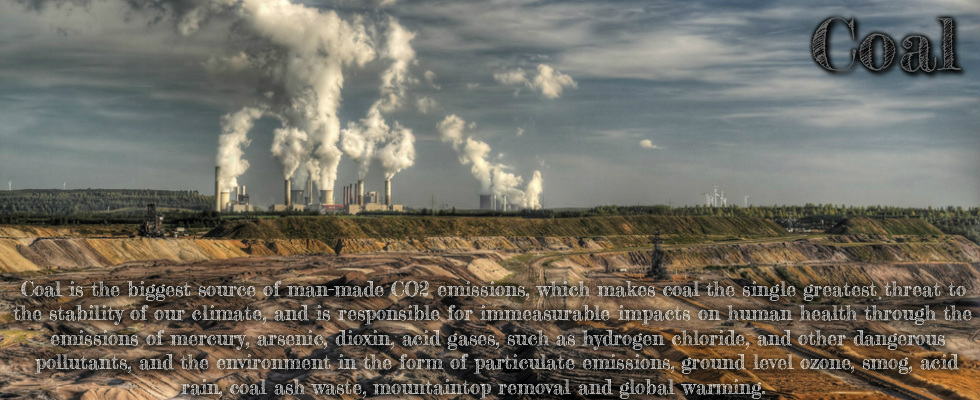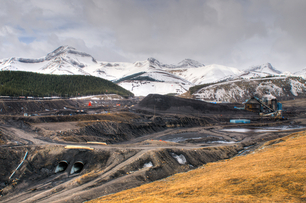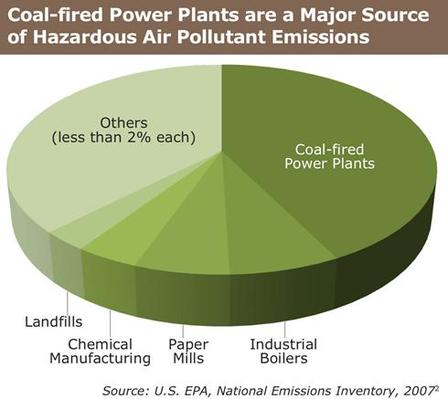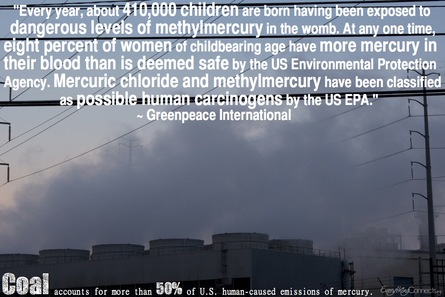
Coal
Coal, which was
formed from prehistoric vegetation that accumulated about 300 million years ago, is an abundant and superficially cheap fossil fuel compared to the soaring prices of oil and natural gas, and accounts for
almost 40% of total worldwide power generation. Coal is also the
biggest source of man-made CO2 emissions, which makes coal the single greatest threat to the stability of our climate, and is responsible for
immeasurable impacts
on
human health
through the emissions of mercury, arsenic, dioxin, acid gases, such as hydrogen chloride, and other dangerous pollutants, and
the environment
in the form of particulate emissions, ground level ozone, smog, acid rain, coal ash waste, mountaintop removal and global warming.
As stated by the Physicians for Social Responsibility, "Coal combustion emissions damage the respiratory, cardiovascular, and nervous systems and contribute to four of the top five leading causes of death in the US: heart disease, cancer, stroke, and chronic lower respiratory diseases. Even people who do not develop illnesses from coal pollutants will find their health and wellbeing impacted due to coal's contribution to global warming. The discharge of carbon dioxide into the atmosphere associated with burning coal is a major contributor to global warming and its adverse effects on health and wellbeing worldwide, such as heat stroke, malaria, declining food production, scarce water supplies, social conflict and starvation." Coal may be traditionally thought of as “cheap” and “affordable,” but it's true costs burdening society and the environment outweigh it's narrow short-term economic benefits and makes
coal the costliest fuel for electricity
imposing more damages on the U.S. economy than the electricity is worth. If these costs were actually accounted for, the
total harm from coal would add “close to 17.8¢/kWh of electricity generated”. The United States' reliance on coal to generate almost half of its electricity,
costs the economy about $345 billion a year in hidden expenses. According to
"Environmental Accounting for Pollution in the United States Economy," by the American Economic Review, which is among the most prestigious academic journals in economics, coal power is actually harming the economy. From mining to combustion, coal is the most polluting and deadliest of all fossil fuels. A future of coal is a future of ravaged landscapes, degraded public health and dangerous global warming.
The Case for Closing America's Costliest Coal Plants
"Power plant pollution kills people. It threatens the brains and nervous system of children. It can cause cancer, heart attacks and strokes. People living closest to these plants, especially children, seniors, pregnant women and those with chronic disease face the greatest risk, but it doesn’t stop there. Pollution from coal-fired power plants takes flight and travels far into other states—threatening public health.” ~ Charles D. Connor, President and CEO of the American Lung Association
Oil and coal-fired power plants
create air pollution damages that are greater than their value added
(view study) (see also), greatly distorting markets.
Global Warming & Air Pollution
Burning coal contributes more to climate change than any other fossil fuel and is the biggest source of man made CO2 emissions driving the world to warm at an
average of 3.5 million tons of CO2 per year, per coal plant, which at
1000 megawatts (MW) produces approximately the same amount of global warming as 1.2 million cars, and with a staggering total of
11 billion tonnes of CO2 emissions
spreading from coal-fired power plants around the world every year. In the United States,
coal is the largest single source of carbon dioxide in the country,
burning more than a billion tons of coal each year, which is
20 pounds of coal
for every person in the country every day, and is
responsible for one-third of America’s
carbon dioxide
emissions, which is about the same amount as all transportation sources, including cars, SUVs, trucks, buses, planes, ships, and trains, combined. If current plans are given the green light to build new coal-fired power plants across the world, then
coal will be responsible for 60% of CO2 emissions by 2030. According to the landmark
Stern Review
on the Economics of Climate Change, the potential cost of dealing with the climate change caused by this CO2 will be 20% or more of the world’s GDP by 2100.
According to Greenpeace, "Worldwide, the 25 worst CO2 polluting power plants all burn coal. According to
CARMA, these plants are responsible for over 570 million metric tonnes of CO2 emissions, the equivalent to
the UK’s yearly fossil fuel related CO2 emissions. Those pedalling technological fixes - such as carbon capture and storage (CCS) create a dangerous distraction. It is only by quitting coal and increasing energy efficiency and production of renewable energy that we will prevent catastrophic climate change."
Learn more.
Not only is coal burning the main contributor to the climate crisis, but it is a leading cause of acid rain, smog, soot and toxic air pollution,
emitting more than 60 different hazardous air pollutants, including a variety of toxic metals, acid gases, arsenic, lead, sulfur dioxide, nitrogen oxides, carbon dioxide, mercury and particulate matter, which wreak havoc on human health, wildlife and ecosystems by
contributing to the formation of small acidic particulates that can penetrate into human lungs and be absorbed by the bloodstream; causing acid rain, which damages crops, forests, and soils, and acidifies lakes and streams; causing ground level ozone, or smog, which can burn lung tissue, exacerbate asthma, and make people more susceptible to chronic respiratory diseases; causing chronic bronchitis, aggravated asthma, and premature death, as well as haze obstructing visibility and causing brain damage and heart problems.
According to the Union of Concerned Scientists, "Other harmful pollutants emitted annually from a typical, uncontrolled coal plant include approximately 720 tons of carbon monoxide, which causes headaches and places additional stress on people with heart disease. 220 tons of hydrocarbons, volatile organic compounds (VOC), which form ozone. 225 pounds of arsenic, which will cause cancer in one out of 100 people who drink water containing 50 parts per billion."
According to the American Lung Association, "Coal-fired power plants that sell electricity to the grid produce more hazardous air pollution in the U.S. than any other industrial pollution sources. More than 400 coal-fired power plants located in 46 states across the country release more that 386,000 tons of hazardous air pollutants into the atmosphere each year. Particle pollution from power plants is estimated to kill approximately 13,000 people a year." According to an
investigation from National Public Radio, The Center for Public Integrity, and the Charleston Gazette, even as the cases of black lung among American coal miners doubled in the last decade, reaching an “epidemic” scale, the coal industry and anti-regulatory politicians have fought back federal agencies from creating new standards that would improve miner safety. Almost
two-thirds of coal-fired plants lack the necessary modern pollution controls
to keep toxic air pollution, like mercury, acid gases and arsenic, out of our air and water.
Human Stories from the Life Cycle of Coal
Coal Harms People of Color and Low-Income Communities the Most:
"Many scientific studies have shown that communities of color are disproportionately exposed to harmful air pollution, including pollution from coal-fired power plants. Over half of the nation’s population lives in counties that have unhealthy levels of air pollution like soot and smog. Furthermore, one study found that 60 percent of Latinos and 50 percent of African- Americans live in areas that are failing two or more national air quality standards, as compared to only 33 percent of whites. One of the contributing factors may be that communities of color and low income communities tend to live in areas that are closer to harmful sources of pollution. African-Americans are more likely to live within 30 miles of a coal-fired power plant. African-Americans and Latinos also tend to live closer to other sources of toxic pollution like waste sites and bus depots, which makes them more likely to develop health problems from air pollution. In addition to living closer to coal-fired power plants, African- Americans also have one of the highest rates of asthma among any cultural group, and are three times as likely as whites to die from asthma. Numerous studies have shown that smog and soot pollution can trigger asthma attacks and increase the need for hospitalizations." ~ Sierra Club: The Dirty Truth About Coal
Effects on Human Health & Economy
Coal-fired power plants emit large amounts of health-threatening toxins, such as
arsenic, mercury, acid gases and lead, into the air every day, which in the U.S. alone can result in more than
$100 billion in annual health costs
and
top over $345 billion in hidden costs, is responsible for
over 127 million - more than 40% - people living in areas with unhealthy levels of air pollution,
cuts short the lives of 30,000 people
and causes
38,000 heart attacks, 12,000 hospital admissions and an additional 550,000 asthma attacks, which strike
nearly 1 out of every 10 school children in the U.S.,
and is the
number-one health issue that causes kids to miss school, especially on “bad-air days," particularly during the warmer summer months, as a result of power plant pollution. Coal may be traditionally thought of as “cheap” and “affordable,” but it's true costs burdening society and the environment outweigh it's narrow economic benefits and makes
coal the costliest fuel for electricity
imposing more damages on the U.S. economy than the electricity is worth. According to
"Environmental Accounting for Pollution in the United States Economy," by the American Economic Review, which is among the most prestigious academic journals in economics, coal power is actually harming the economy. By modeling the physical and economic consequences of coal emissions of six major pollutants from 10,000 pollution sources in the U.S., the estimated "gross external damages" from the sickness and death caused by pollution in comparison to the value added to the economy is
over twice as high as the market price for the electricity.
According to the study, "Solid waste combustion, sewage treatment, stone quarrying, marinas, and oil and coal-fired power plants have air pollution damages larger than their value added. The largest industrial contributor to external costs is coal-fired electric generation, whose damages range from 0.8 to 5.6 times value added. Coal plants are responsible for more than one-fourth of GED [gross external damages] from the entire US economy. The damages attributed to this industry are larger than the combined GED due to the three next most polluting industries: crop production, $15 billion/year, livestock production, $15 billion/year, and construction of roadways and bridges, $13 billion/ year."
According to Coal is Dirty, "Despite coal industry claims that coal mining creates lots of jobs, the truth is that
coal mining employment has been declining for decades,
due to increased use of machinery instead of manpower. In West Virginia alone, coal mining employment has plummeted from 126,000 miners in 1948 (who produced 168 million tons of coal), to just 15,000 miners employed in 2005 (who, with the help of machinery, produced 128 million tons of coal)." Furthermore, the Center for Disease Control (CDC) estimates that
12,000 coal miners died
from black lung disease between 1992 and 2002.
Sierra Club: The Cost of Coal.
Burning coal releases large amounts of the neurotoxin mercury into the air,
accounting for over 50% of the mercury pollution caused by humans, which
harm the brain, heart, kidneys, lungs, and immune system of people of all ages
and can
cause brain damage, mental retardation, blindness, seizures and the inability to speak and is especially damaging to fetuses, infants and young children because it affects the development of the nervous system. Coal mine workers also face serious health problems, including
lung disease from prolonged exposure to coal dust in mines.
According to Greenpeace, "Every year, about 410,000 children are born having been exposed to dangerous levels of methylmercury in the womb. At any one time, eight percent of women of childbearing age have more mercury in their blood than is deemed safe by the US Environmental Protection Agency. Mercuric chloride and methylmercury have been classified as possible human carcinogens by the US Environmental Protection Agency. Coal-burning power plants release fine particles of sulphate, nitrates, ammonia, sodium chloride, carbon and mineral dust, smaller than the width of a human hair, that penetrate deep into the lung. Breathing these fine particles can decrease lung function, aggravate asthma and contribute to cardiovascular disease." Furthermore,
coal emissions lead to smog, or ground-level ozone, which is a toxic compound and dangerous irritant that doctors compare to getting a sunburn on your lungs. Smog can
cause chest pain, coughing, breathing difficulties, trigger asthma attacks, exacerbate conditions like bronchitis, emphysema, and asthma, sometimes fatally, and lead to irreversible lung damage or even death. The developing lungs of children who are active outdoors are at the greatest health risk from these air pollutants.
According to the Sierra Club, "Soot pollution—a byproduct from burning fossil fuels that results in small particles in the air comprised of a mixture of metals, chemicals, and acid droplets—is one of the deadliest and most dangerous air pollutants. The smallest soot particles are less than one-30th the width of a human hair. Because of their minuscule size, this fine particulate matter can travel deep into our lungs and even enter the bloodstream. Exposure to soot pollution is extremely dangerous and is linked to premature death, heart attacks, lung damage, and a variety of other significant health problems. Stronger soot standards could avoid up to
35,700 premature deaths, 23,290 visits to the emergency room, and 2.7 million days of missed work or school
due to air pollution-caused ailments every year."
Photos: Documenting the True Cost of Coal
Physicians for Social Responsibility: Coal's Assault on Human Health
Mountaintop Removal Coal Mining
Mountaintop Removal Coal Mining
Mountaintop removal coal mining uses millions of pounds of heavy explosives, to the tune of
one Hiroshima-strength atomic bomb detonating every week, to extract coal by literally blowing up
800-1000 vertical feet of mountaintop
to access the thin seams of coal within and dumps the millions of tons of rubble and toxic waste, known as "overburden," directly into adjacent streams and valleys burying and destroying virtually everything below the mining sites, which has a devastating impact on the economy, ecology, and communities. In Appalachia alone,
over 500 mountains have been leveled and nearly 2,000 miles of precious Appalachian headwater streams have been buried
and
according to 21 peer-reviewed scientific studies, people living near mountaintop mining have cancer rates of 14.4% compared to 9.4% for people elsewhere in Appalachia, the rate of children born with birth defects is 42% higher in mountaintop removal mining areas, the public health costs of pollution from coal operations in Appalachia amount to a staggering $75 billion a year and people living near the destruction are 50% more likely to die of cancer and 42% more likely to be born with birth defects compared with other people in Appalachia. Nationally, about
1 in every 33 children
born in the US are born with some form of birth defect. People who live near mountaintop removal coal mining areas have a
26% higher chance of birth defects
(view study).
According to the Sierra Club, mountaintop removal coal mining poisons drinking water by causing toxic heavy metals such as cadmium, selenium, and arsenic to leach into local water supplies, destroys beautiful, biodiverse forests and wildlife habitat, increases the risk of flooding, causes air pollution that affects communities for miles around with toxins, many of which are carcinogens, that have led to cancer rates being twice as high for people living near mountaintop removal sites, and threatens to destroy 1.4 million acres of mountaintops and forests in Appalachia by 2020.
View 'The Last Mountain' Movie
Further Impacts of Mountaintop Removal Coal Mining
Coal mining wastes enormous amounts of water by requiring an estimated
70 to 260 million gallons
of water every day, which
along with the nuclear has over 15 times the water footprint of renewable energy sources, and uses
800 - 3,000 gallons of water to extract, process and dispose of each ton of coal. With
1 billion tons of coal used every year in the U.S., that equates to as much as 75 trillion gallons of water wasted on dirty energy each year. Moreover, coal mining
creates
more than 120 million solid tons of waste products annually, which is enough to fill a million railcars every year or a train that is 9,600 miles long, that contain toxic levels of heavy metals and minerals which largely end up in landfill sites and pose a threat to human health and the environment. Coal emissions are the
largest source
of human-generated mercury pollution in the U.S.,
accounting for more than 50% U.S. human-caused emissions of mercury, which is a
powerful neurotoxin that rains down into rivers and streams accumulating in the food chain via algae and infecting all life forms, from predator fish to birds and mammals, whose diets include fish, and eventually makes its way into our bodies when we eat contaminated fish
causing brain damage and heart problems. Despite this,
mercury emissions from electrical generation
continue to rise, which has led to
polluted seafood and freshwater, forcing 49 U.S. states to issue
fish consumption advisories
due to high mercury concentrations in freshwater bodies throughout the country. Mercury emissions are being
blamed for a litany of neurological impacts
in infants and young children during their most vulnerable periods of brain and nervous system development, and has even
spread into mothers' blood and breast milk, which interferes with the development of babies' brains and neurological systems and can lead to
blindness, seizures, learning disabilities, attention deficit disorder, problems with coordination, delayed onset of walking and talking in babies and infants, lowered IQ and even mental retardation. The amount of mercury in the atmosphere is
estimated to have increased by 200% - 500% since the beginning of the industrial revolution, when coal use skyrocketed.
According to the Union of Concerned Scientists, "Just 1/70th of a teaspoon of mercury deposited on a 25-acre lake can make the fish unsafe to eat. A typical uncontrolled coal plants emits approximately 170 pounds of mercury each year. Activated carbon injection technology can reduce mercury emissions by up to 90 percent when combined with baghouses. ACI technology is currently found on just 8 percent of the U.S. coal fleet."
10 Reasons Why
'Clean Coal' is Offensive
"Coal’s defenders often point to the “200,000 tons of mercury that already exist in the soils and seas of the planet” to downplay the idea that we should be concerned about the 48 tons of mercury that coal-fired plants emit per year. But the fact that mercury exists in buried soils doesn’t mean that it has always contaminated the aquatic food chain and the hydrologic system. In fact, the mercury bound in soils and geological strata largely stays put. Mercury levels in fish and humans have risen sharply in the past 200 years, concurrent with the burning of enormous quantities of coal which releases mercury into the atmosphere and contaminates our air and water. In fact, the U.S. Environmental Protection Agency (EPA) reports that the amount of mercury in the atmosphere is estimated to have increased by 200% to 500% since the beginning of the industrial revolution, when coal use skyrocketed. The US Department of Energy (DOE) projects that mercury emissions will continue to rise." ~ Coal is Dirty
"Coal is the single greatest threat to civilization and all life on our planet." ~James Hansen, NASA's top climate scientist Learn more.
Discover Over 40 Years of Coal Advertisements Insulting Our Intelligence
...and some embarrassing advertisement tricks:
...and some embarrassing advertisement tricks:








